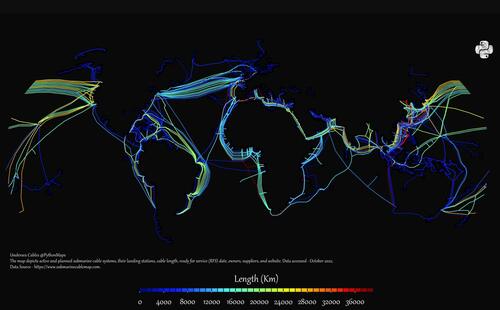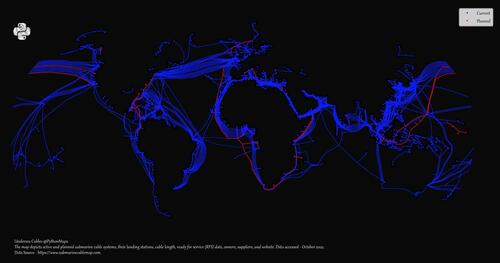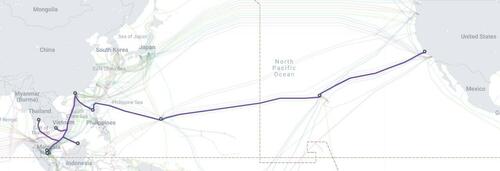Charting The Depths: The World Of Subsea Cables
Data may be stored in the “cloud,” but when it comes to sending and receiving data, a lot of that action is actually happening along the depths of the ocean floor.
Hidden beneath the waves, these subsea cables account for approximately 95% of international data transmission.
As Visual Capitalists’ Bruno Venditti details below, these maps, by Adam Symington, use information from TeleGeography to show the distribution of subsea cables around the planet.
Wired for Connectivity
It’s estimated that there are nearly 1.4 million kilometers (0.9 million miles) of submarine cables in service globally. They ensure emails, content, and calls find their way, linking colossal data centers and facilitating worldwide communication.
Currently, there are 552 active and planned submarine cables:
Submarine cables harness fiber-optic technology, transmitting information via rapid light pulses through glass fibers. These fibers, thinner than human hair, are protected by plastic or even steel wire layers.
Cables usually have the diameter of a garden hose, but often with added armor near the shore. Coastal cables are buried under the seabed, hidden from view on the beach, while deep-sea ones rest on the ocean floor.
Length varies widely, from the 131-kilometer CeltixConnect cable, connecting Dublin, Ireland, and Holyhead, UK, to the sprawling 20,000-kilometer Asia America Gateway cable, connecting San Luis Obispo, California, to Hawaii and Southeast Asia:
Asia America Gateway. Image: TeleGeography
With the current technology, cables are designed to last 25 years at least but are often replaced because of damage. Nearly two-thirds of cable damage is caused by fishing vessels and ships dragging anchors.
The Bottom Line
Traditionally dominated by telecom carriers, the makeup of the subsea cable market has shifted over more recent decades. Tech giants like Google, Facebook, Microsoft, and Amazon now heavily invest in new cables.
With data demand surging, at least $10 billion is expected to be invested in subsea cables worldwide between 2022 and 2024, driven by cloud service providers and content streaming platforms.
Even with the growth of satellites in telecom, cables still can carry far more data at a much lower cost than satellites. In fact, according to TeleGeography, satellites account for less than 1% of all U.S. international capacity.
Tyler Durden
Sun, 10/01/2023 – 23:00
via ZeroHedge News https://ift.tt/BzRphbf Tyler Durden


